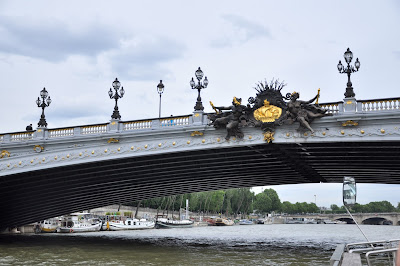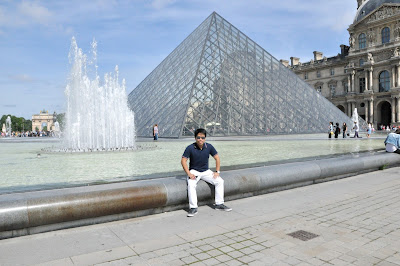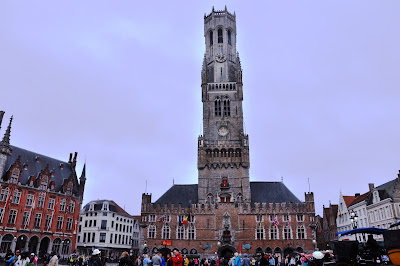June 28 - 30, 2016
Paris can be seen as the most interesting city of Europe and probably even as one of the most amazing cities worldwide. It is the city of love, inspiration, art and fashion. The night scene, the Eiffel tower and the warm atmosphere will make you feel directly at home. Paris has a lot of interesting architecture and museums to offer, and is also a Walhalla for shopaholics. Paris is a city that everyone should visit and experience. -> www.paris.eu/information/.
The Eiffel Tower
The Eiffel Tower, one of the must sees in Paris, was built by the French engineer Gustave Eiffel. He was famous at that time for building bridges. Although Eiffel Tower is now one of the most recognizable monuments in Europe, it was not supposed to be permanent when it was first introduced. After it was built, it faced a lot of criticism from Paris' artistic and literary elite. The tower was almost torn down sometime in 1909. The only reason it was eventually kept was its ability to provide a perfect platform for transmitting antennas.
Slowly, the Eiffel Tower became a permanent part of Paris view, settling in the hearts of Parisians as the symbol of Paris providing it with the most beautiful and famous skyline during the evening.
Source: www.visitacity.com
Notre Dame Cathedral
The Notre Dame Cathedral is not only a Gothic architecture masterpiece but a site which was also the focus of Catholic Paris for 700 years. It could host 5,000 worshippers at a given pray. Some if its exceptional structures include the spectacular rose windows.
The work on the cathedral began around 1163, which took 182 years to complete. At the beginning of the 13th century, it was the largest cathedral in France. At some point, the cathedral was scheduled for deconstruction but due to the incredible popularity of the book Hunchback of Notre-Dame(by Victor Hugo), the cathedral stayed untouched and eventually restored to its original glory.
There are 420 spiraling stairs that will bring you all the way up where you will find the cathedral's most frightening statues in a very close range. The South Tower will reveal a spectacular view of Paris.
Source: www.visitacity.com
Louvre Museum
The entrance to the Louvre Museum is a glass pyramid, one of the city's most distinct symbols and has become a tourist attraction by itself as no photo album of Paris seems to be complete without it.
The Louvre Museum is the largest art museum in the world and the home for one of the finest art collections anywhere to be seen including two of the most famous painted women - Mona Lisa and Venus de Milo - just to name two out of the 30,000 exhibits displayed. This gigantic museum stretches for almost half a mile (750 meters).
It was François I and Louis XIV who purchased most of the paintings and sculptures while the rest were contributed or purchased (and in many cases simply taken) by Napoleon later to be returned to the original owner’s family.
The most famous smile in the world, the Mona Lisa, was ordered by François I from Leonardo the Vinci. It gained popularity after it was stolen in 1911 by a Louvre employee, who simply left the building with the painting under his coat.
Source: www.visitacity.com
Arc de Triomphe
Champ de Mars
The Champ de Mars (in English – "Field of Mars") is a large public green park, one of the nicest parks in Paris for families, located just between the Eiffel Tower and the École Militaire . The grassy field with lines of trees crossing it was originally created to host parades of the French Military Academy. Today, the park is one of the best spots for picnics or just for hanging out. It is even allowed to walk on the grass itself which is very unusual for Paris.
Source: www.visitacity.com
River Cruise
If you want to see a new perspective of the famous sites of Paris, you have to cruise up the majestic Seine. From the water, you could see the beauty of the bridges and monuments of Paris.
Of course, the NBIs did not miss it. :)
The main Bateaux Parisiens pier is located close to the Eiffel Tower.
Few More Shots in Paris
Next stop: Switzerland!
See also:
My Europe Tour: Amsterdam, Netherlands
My Europe Tour: Other NL Areas
My Europe Tour: Bruges, Belgium
My Europe Tour: Switzerland
My Europe Tour: Milan, Italy
My Europe Tour: Venice, Italy
My Europe Tour: Florence, Italy
My Europe Tour: Rome, Italy
Paris can be seen as the most interesting city of Europe and probably even as one of the most amazing cities worldwide. It is the city of love, inspiration, art and fashion. The night scene, the Eiffel tower and the warm atmosphere will make you feel directly at home. Paris has a lot of interesting architecture and museums to offer, and is also a Walhalla for shopaholics. Paris is a city that everyone should visit and experience. -> www.paris.eu/information/.
 |
| We left Bruges at around 2 pm and set foot in Paris at around 5 pm of June 28. Taking a picture of us while waiting for our train to the city of love. NBI's quite tired :p |
The Eiffel Tower
The Eiffel Tower, one of the must sees in Paris, was built by the French engineer Gustave Eiffel. He was famous at that time for building bridges. Although Eiffel Tower is now one of the most recognizable monuments in Europe, it was not supposed to be permanent when it was first introduced. After it was built, it faced a lot of criticism from Paris' artistic and literary elite. The tower was almost torn down sometime in 1909. The only reason it was eventually kept was its ability to provide a perfect platform for transmitting antennas.
Slowly, the Eiffel Tower became a permanent part of Paris view, settling in the hearts of Parisians as the symbol of Paris providing it with the most beautiful and famous skyline during the evening.
Source: www.visitacity.com
 |
| View of Eiffel Tower from Notre Dame. |
 |
| A view from underneath! |
The Notre Dame Cathedral is not only a Gothic architecture masterpiece but a site which was also the focus of Catholic Paris for 700 years. It could host 5,000 worshippers at a given pray. Some if its exceptional structures include the spectacular rose windows.
The work on the cathedral began around 1163, which took 182 years to complete. At the beginning of the 13th century, it was the largest cathedral in France. At some point, the cathedral was scheduled for deconstruction but due to the incredible popularity of the book Hunchback of Notre-Dame(by Victor Hugo), the cathedral stayed untouched and eventually restored to its original glory.
There are 420 spiraling stairs that will bring you all the way up where you will find the cathedral's most frightening statues in a very close range. The South Tower will reveal a spectacular view of Paris.
Source: www.visitacity.com
 |
| While waiting for our turn to climb the 420 steps. We waited for 2 hours to see the huge bell in Victor Hugo's famous novel, and the panoramic view of Paris. |
 |
| A view of Paris from the top of Notre Dame Cathedral. |
Louvre Museum
The entrance to the Louvre Museum is a glass pyramid, one of the city's most distinct symbols and has become a tourist attraction by itself as no photo album of Paris seems to be complete without it.
The Louvre Museum is the largest art museum in the world and the home for one of the finest art collections anywhere to be seen including two of the most famous painted women - Mona Lisa and Venus de Milo - just to name two out of the 30,000 exhibits displayed. This gigantic museum stretches for almost half a mile (750 meters).
It was François I and Louis XIV who purchased most of the paintings and sculptures while the rest were contributed or purchased (and in many cases simply taken) by Napoleon later to be returned to the original owner’s family.
The most famous smile in the world, the Mona Lisa, was ordered by François I from Leonardo the Vinci. It gained popularity after it was stolen in 1911 by a Louvre employee, who simply left the building with the painting under his coat.
Source: www.visitacity.com
Arc de Triomphe
The Arc de Triomphe, inspired by Rome's Arch of Titus, is located in the world’s largest traffic roundabout and is the biggest and tallest triumphal arch in the world - about 49 meters (161 ft.) high and 44 meters (144 ft.) wide. This triumphal arch was commissioned by Napoléon in 1806 to honor his imperial victories but it is only 20 years after he died that the Arc de Triomphe was finished, i.e., in 1836.
Some important events took place under the great Arc de Triomphe. The greatest state funeral, for one, was of Victor Hugo. His coffin was placed in 1885 here while many Parisians came to place their last respect. On the other hand, some of France most humiliating moments are also related to this place, notably in 1871 and 1940. The sights of German troops walking under the arch are not to be forgotten by the French people.
Source: www.visitacity.com
Champ de Mars
The Champ de Mars (in English – "Field of Mars") is a large public green park, one of the nicest parks in Paris for families, located just between the Eiffel Tower and the École Militaire . The grassy field with lines of trees crossing it was originally created to host parades of the French Military Academy. Today, the park is one of the best spots for picnics or just for hanging out. It is even allowed to walk on the grass itself which is very unusual for Paris.
Source: www.visitacity.com
 |
| A shot from the 1st floor of the Eiffel Tower. |
River Cruise
If you want to see a new perspective of the famous sites of Paris, you have to cruise up the majestic Seine. From the water, you could see the beauty of the bridges and monuments of Paris.
Of course, the NBIs did not miss it. :)
The main Bateaux Parisiens pier is located close to the Eiffel Tower.
 |
| A wedding reception! |
 |
 |
| A view of Notre Dame Cathedral from the water! |
 |
| Paris' modern part of the city. |
 |
| Caption this! |
Few More Shots in Paris
Next stop: Switzerland!
See also:
My Europe Tour: Amsterdam, Netherlands
My Europe Tour: Other NL Areas
My Europe Tour: Bruges, Belgium
My Europe Tour: Switzerland
My Europe Tour: Milan, Italy
My Europe Tour: Venice, Italy
My Europe Tour: Florence, Italy
My Europe Tour: Rome, Italy















































